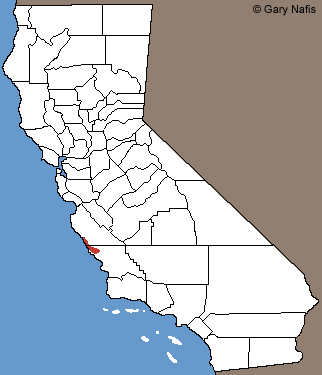|
 |
 |
 |
| Adult, San Luis Obispo County |
Adult, San Luis Obispo County |
Adult, San Luis Obispo County |
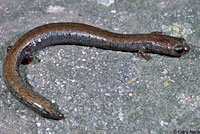 |
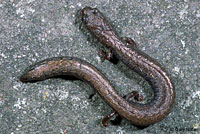 |
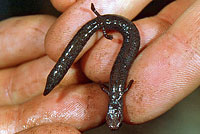 |
| Adult, with regenerating tail, San Luis Obispo County |
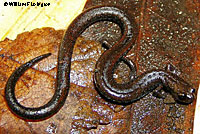 |
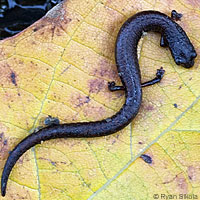 |
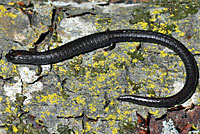 |
Adult, Monterey County
© William Flaxington |
Adult, San Luis Obispo County
© Ryan Sikola |
Adult, San Luis Obispo County |
 |
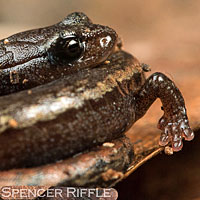 |
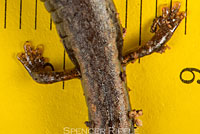 |
| Adult, San Luis Obispo County © Spencer Riffle (Note the large toes.) |
Adult, San Luis Obispo County
© Spencer Riffle |
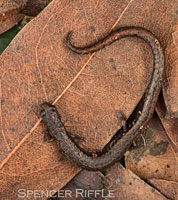 |
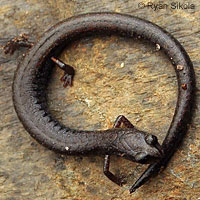 |
 |
Adult, San Luis Obispo County
© Spencer Riffle |
Adult, San Luis Obispo County
© Ryan Sikola |
Adult, San Luis Obispo County
© Spencer Riffle |
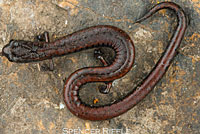 |
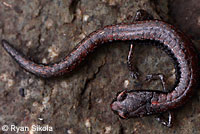 |
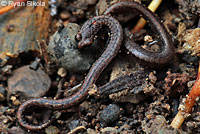 |
Adult, San Luis Obispo County
© Spencer Riffle |
Juvenile, Monterey County
© Ryan Sikola |
Adults, Monterey County
© Ryan Sikola |
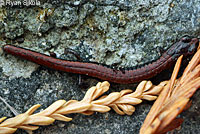 |
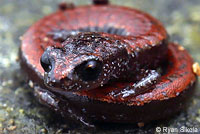 |
s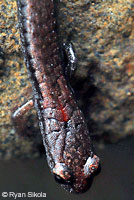 |
Adult, Monterey County
© Ryan Sikola |
Adult, Monterey County
© Ryan Sikola |
Adult, Monterey County
© Ryan Sikola |
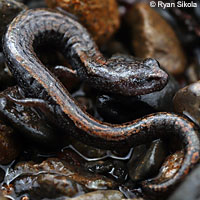 |
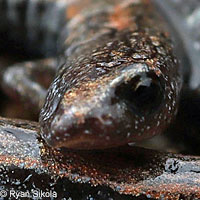 |
 |
This San Simeon Slender Salamander, found in Monterey County,
has lost its right eye. © Ryan Sikola |
Slender Salamanders (genus Batrachoseps) have only 4 toes on their hind feet. All other California salamanders have 5 toes on their hind feet. |
| |
|
|
| Comparisons With the Sympatric Species B. nigriventris - Black-bellied Slender Salamander |
Coexists with B. nigriventris - Black-bellied Slender Salamander, in some areas of northern San Luis Obispo County.
B. incognitus is the larger, more robust, of the two species, with longer limbs and a broader neck and head than B. nigriventris.
The digits of the toes of B. incognitus are individually distinct, and easier to see when compared to B. nigriventris which has smaller digits.
|
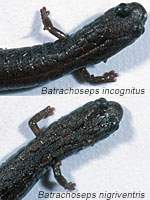 |
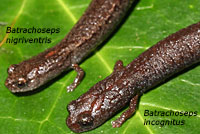 |
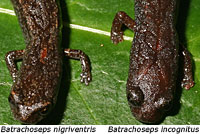 |
Top: B. incognitus
Bottom: B. nigriventris - Black-bellied Slender Salamander
B. incognitus has slightly larger legs and toes and neck. |
Left: B. nigriventris - Black-bellied Slender Salamander
Right: B. incognitus
B. incognitus has slightly larger legs and toes and neck.
|
| |
|
| Habitat |
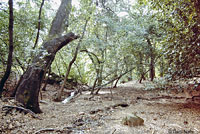 |
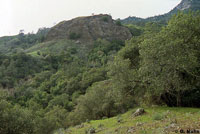 |
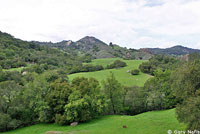 |
| Habitat, San Luis Obispo County |
Habitat, San Luis Obispo County |
Habitat, San Luis Obispo County |
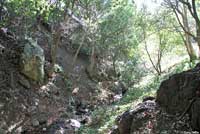 |
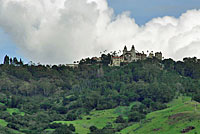 |
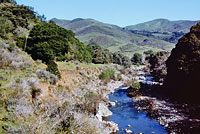 |
| Habitat, San Luis Obispo County |
San Simeon, San Luis Obispo County |
Habitat, San Luis Obispo County |
| |
|
|
| Description |
| |
| Size |
Adults are 1 1/2 - 1 9/10 inches long (3.8 - 4.8 cm) from snout to vent.
|
| Appearance |
A small thin salamander with 18-20 costal grooves.
Short limbs, a narrow head, long slender body, very long tail, and conspicuous costal and caudal grooves give this species the worm-like appearance typical of most Slender Salamanders.
There are four toes on the front and hind feet, which is typical of all Slender Salamanders.
(Other California salamanders have five toes on the hind feet.)
|
| Color and Pattern |
Ground color is dark grey to brown or reddish brown.
There may be a faint dorsal stripe.
The venter is lighter in color than the dorsum and finely speckled.
|
| Comparison With Sympatric Slender Salamanders |
Co-exists with B. nigriventris in some areas.
B. incognitus is the larger, more robust, of the two species, with longer limbs and a broader neck and head than B. nigriventris.
The digits of the toes are individually distinct, and easier to see when compared to B. nigriventris which has smaller digits.
|
| Life History and Behavior |
A member of family Plethodontidae, the Plethodontid or Lungless Salamanders.
Plethodontid salamanders do not breathe through lungs. They conduct respiration through their skin and the tissues lining their mouth. This requires them to live in damp environments on land and to move about on the ground only during times of high humidity. (Plethodontid salamanders native to California do not inhabit streams or bodies of water but they are capable of surviving for a short time if they fall into water.)
Plethodontid salamanders are also distinguished by their nasolabial grooves, which are vertical slits between the nostrils and upper lip that are lined with glands associated with chemoreception.
All Plethodontid Salamanders native to California lay eggs in moist places on land.
The young develop in the egg and hatch directly into a tiny terrestrial salamander with the same body form as an adult.
(They do not hatch in the water and begin their lives as tiny swimming larvae breathing through gills like some other types of salamanders.)
|
| Activity |
Active on rainy or wet nights when temperatures are moderate, fall through spring.
Surface activity has been observed from mid January to early June, but activity probably begins with the first fall precipitation in October or November and may continue after the rains when cool temperatures and moisture are provided by marine fog drip.
Retreats underground when the soil dries or when air temperature drops to near freezing.
Usually found under rocks, logs, bark, and other debris.
|
| Defense |
Slender salamanders use several defense tactics, including:
- Coiling and remaining still, relying on cryptic coloring to avoid detection.
- Uncoiling quickly and springing away repeatedly bouncing over the ground, then remaining still again to avoid detection.
- Detaching the tail, which wriggles on the ground to distract a predator from the salamander long enough for it to escape.
(After its tail is detached or severed, the salamander will grow a new tail.) |
| Diet and Feeding |
Probably eats a variety of small invertebrates.
Feeding behavior is not known, but other Batrachoseps species are sit-and-wait predators that use a projectile tongue to catch prey. |
| Reproduction |
Reproduction is terrestrial.
Little is known about the breeding behavior of this species.
|
| Eggs |
| Typically, Batrachoseps females lay eggs in moist places underground. |
| Young |
Young develop completely in the egg and hatch fully formed.
|
| Habitat |
Inhabits open and closed forests of yellow pine, laurel, sycamore, and oak woodland.
|
| Geographical Range |
| Endemic to the central coast of California. Found only in the Santa Lucia Mountains in northwestern San Luis Obispo County and southwestern Monterey County. The northern and eastern range limits in Monterey County are not yet known, extending at least as far north as Prewitt Creek. |
| Elevational Range |
From sea level to near 3,280 ft. (1,000 m.)
|
| Notes on Taxonomy |
Prior to its description in 2001, B. incognitus was recognized as B. pacificus which has been split into ten species based on
molecular studies.
Here's a Diagram of the Batrachoseps Complex showing the relationships between species.
Alternate and Previous Names (Synonyms)
Batrachoseps incognitus - San Simeon Slender Salamander (Jockusch, Yanev, Wake 2001, Stebbins 2003, 2012)
Batrachoseps pacificus - Pacific Slender Salamander (Stebbins 1985)
Batrachoseps attenuatus - California Slender Salamander (Stebbins 1954, 1966)
Batrachoseps attenuatus attenuatus - Worm-salamander (Bishop 1943)
Batrachoseps attenuatus - Slender Salamander (Storer 1925)
Batrachoseps nigriventris (Cope 1869)
Batrachoseps attenuatus (Cooper 1868)
Batrachoseps attenuata (Baird 1850)
Salamandrina attenuata (Eschscholtz 1833)
|
| Conservation Issues (Conservation Status) |
| No significant threats are known to this species, but its small range on mostly private property and its similarity to other species make it difficult to survey and get a clear picture of its status. |
|
| Taxonomy |
| Family |
Plethodontidae |
Lungless Salamanders |
Gray, 1850 |
| Genus |
Batrachoseps |
Slender Salamanders |
Bonaparte, 1841 |
Species
|
incognitus |
San Simeon Slender Salamander |
Jockusch, Yanev & Wake, 2001 |
|
Original Description |
Elizabeth L. Jockusch, Kay P. Yanev, and David B. Wake ''Molecular phylogenetic analysis
of slender salamanders, genus Batrachoseps (Amphibia: Plethodontidae), from central coastal
California with descriptions of four new species.'' Herpetological Monographs, #15 2001.
|
|
Meaning of the Scientific Name |
Batrachoseps - Greek - batrachos = amphibian, frog + seps = lizard — describes lizard-like appearance
incognitus - Latin = unknown, in reference to the unexpected discovery that these populations constitute a distinct
species, and to its small geographic range.
from Scientific and Common Names of the Reptiles and Amphibians of North America - Explained © Ellin Beltz
|
|
Similar Neighboring Salamanders |
Batrachoseps nigriventris
Batrachoseps minor
Batrachoseps luciae
Batrachoseps gavilanensis
|
|
More Information and References |
California Department of Fish and Wildlife
AmphibiaWeb
Elizabeth L. Jockusch, Kay P. Yanev, and David B. Wake ''Molecular phylogenetic analysis of slender salamanders, genus Batrachoseps (Amphibia: Plethodontidae), from central coastal California with descriptions of four new species.'' Herpetological Monographs, #15 2001.
Hansen, Robert W. and Shedd, Jackson D. California Amphibians and Reptiles. (Princeton Field Guides.) Princeton University Press, 2025.
Stebbins, Robert C., and McGinnis, Samuel M. Field Guide to Amphibians and Reptiles of California: Revised Edition (California Natural History Guides) University of California Press, 2012.
Stebbins, Robert C. California Amphibians and Reptiles. The University of California Press, 1972.
Flaxington, William C. Amphibians and Reptiles of California: Field Observations, Distribution, and Natural History. Fieldnotes Press, Anaheim, California, 2021.
Nicholson, K. E. (ed.). 2025. Scientific and Standard English Names of Amphibians and Reptiles of North America North of Mexico, with Comments Regarding Confidence in Our Understanding. Ninth Edition. Society for the Study of Amphibians and Reptiles. [SSAR] 87pp.
Samuel M. McGinnis and Robert C. Stebbins. Peterson Field Guide to Western Reptiles & Amphibians. 4th Edition. Houghton Mifflin Harcourt Publishing Company, 2018.
Stebbins, Robert C. A Field Guide to Western Reptiles and Amphibians. 3rd Edition. Houghton Mifflin Company, 2003.
Behler, John L., and F. Wayne King. The Audubon Society Field Guide to North American Reptiles and Amphibians. Alfred A. Knopf, 1992.
Robert Powell, Roger Conant, and Joseph T. Collins. Peterson Field Guide to Reptiles and Amphibians of Eastern and Central North America. Fourth Edition. Houghton Mifflin Harcourt, 2016.
Powell, Robert., Joseph T. Collins, and Errol D. Hooper Jr. A Key to Amphibians and Reptiles of the Continental United States and Canada. The University Press of Kansas, 1998.
American Museum of Natural History - Amphibian Species of the World 6.2
Bartlett, R. D. & Patricia P. Bartlett. Guide and Reference to the Amphibians of Western North America (North of Mexico) and Hawaii. University Press of Florida, 2009.
Bishop, Sherman C. Handbook of Salamanders. Cornell University Press, 1943.
Lannoo, Michael (Editor). Amphibian Declines: The Conservation Status of United States Species. University of California Press, June 2005.
Petranka, James W. Salamanders of the United States and Canada. Smithsonian Institution, 1998.
|
|
|
The following conservation status listings for this animal are taken from the April 2024 State of California Special Animals List and the April 2024 Federally Listed Endangered and Threatened Animals of California list (unless indicated otherwise below.) Both lists are produced by multiple agencies every year, and sometimes more than once per year, so the conservation status listing information found below might not be from the most recent lists. To make sure you are seeing the most recent listings, go to this California Department of Fish and Wildlife web page where you can search for and download both lists:
https://www.wildlife.ca.gov/Data/CNDDB/Plants-and-Animals.
A detailed explanation of the meaning of the status listing symbols can be found at the beginning of the two lists. For quick reference, I have included them on my Special Status Information page.
If no status is listed here, the animal is not included on either list. This most likely indicates that there are no serious conservation concerns for the animal. To find out more about an animal's status you can also go to the NatureServe and IUCN websites to check their rankings.
Check the current California Department of Fish and Wildlife sport fishing regulations to find out if this animal can be legally pursued and handled or collected with possession of a current fishing license. You can also look at the summary of the sport fishing regulations as they apply only to reptiles and amphibians that has been made for this website.
|
| Organization |
Status Listing |
Notes |
| NatureServe Global Ranking |
G2 |
Imperiled |
| NatureServe State Ranking |
S2 |
Imperiled
|
| U.S. Endangered Species Act (ESA) |
None |
|
| California Endangered Species Act (CESA) |
None |
|
| California Department of Fish and Wildlife |
None |
|
| Bureau of Land Management |
None |
|
| USDA Forest Service |
S |
Sensitive |
| IUCN |
DD |
Data Deficient |
|
|
|
